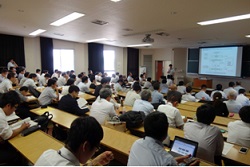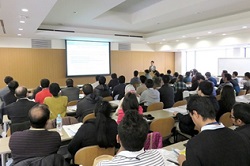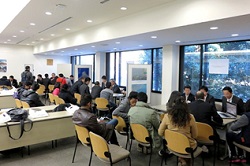IAC News
IAC News No.40, February 2016
Japan Society of Civil Engineers International Activities Center Feb. 1, 2016 IAC News No.40

Prof. Yoshiaki Okui (Saitama University)
Chair of the Committee on Hybrid Structures
Introduction of the Committee on Hybrid Structures
The Japan Society of Civil Engineers (JSCE) started work on hybrid structures in 1978 by establishing the Subcommittee on Steel-Concrete Composite Structures. The subcommittee’s activities included publishing the Guidelines for Design of Steel-Concrete Composite Constructions. The subcommittee ceased its activities in November 1993. However, with the increasing use of hybrid structures, there was strong demand for research on steel-concrete hybrid structures, which led to the establishment of the Joint Subcommittee on Steel-Concrete Hybrid Structures in November 1994 as a joint subcommittee between the Committee on Concrete, the Committee on Structural Engineering, and the Committee on Steel Structures. The 10-year activities of the subcommittee included publishing the Guideline of Performance Verification of Hybrid Structures (draft). Based on the results of these efforts and the possibilities of composite structures, the Committee on Hybrid Structures was established in FY 2005.
Since its establishment 10 years ago, the Committee on Hybrid Structures has been working on the development and adoption of technologies related to various structures including hybrid structures based on steel and concrete, and structures using composite materials such as FRP. Its activities include conducting researches, holding workshops and symposiums, and publishing the Standard Specifications for Hybrid Structures. The Standard Specifications for Hybrid Structures (2009 edition) focused on designing. However, civil engineering projects encompass the processes of planning, design, construction, and maintenance. In order to apply the processes of design, construction, and maintenance to hybrid structures, the 2014 edition of the standard specifications was issued by adding sections on Construction and Maintenance, and revising the Design section to include FRP. With a view to encouraging the creation of new forms of hybrid structures and providing practical convenience, each of the Design, Construction
and Maintenance sections of the 2014 edition was composed of Standards and Specifications volumes.
With regard to international exchange activities, we set up a permanent subcommittee for international coordination, and held the joint seminar “Recent Progress of Concrete-Steel Hybrid Structures” at an annual meeting of the Korean Society of Civil Engineers (KSCE) in October 2006 shortly after the establishment of the Committee on Hybrid Structures. We also held a joint seminar at the “7th Symposium on Application of Hybrid Structures” in November 2007. More recently, together with the Committee on Steel Structures, we jointly held the “IABSE-JSCE Joint Conference on Advances in Bridge Engineering-III” in Dhaka, Bangladesh in August 2015. It was supported by International Scientific Exchange Fund, JSCE.
Individual members of the Committee on Hybrid Structures are also actively pursuing international exchanges. For example, Professor Tamon Ueda (Hokkaido University), the first chairman of the committee, became the first Senior Director of the International Activities Center.
Other activities of the committee include the “Symposium on Research and Application of Hybrid and Composite Structures” and the “Symposium on FRP Hybrid Structures and Bridges”, which we have been holding every other year since 2005, the management of a common session (hybrid structures) at the annual meetings, and the planning and management of seminars. We have also been publishing feature issues (hybrid structures) of the Japan Society of Civil Engineers’ journals since FY 2014 to distribute information on outstanding research results both in Japan and overseas.
In the future, we need to undertake further internationalization activities such as publishing an English version of the specifications.
 JSCE seminar held on September 18, 2015 |
 Standard Specifications for Hybrid Structures published by the Committee on Hybrid Structures |
The 3rd Joint Company Information Session in Civil Engineering for International Students 2015
The IAC International Student Network Group hosted a joint company information session for international students at the JSCE headquarters on Saturday, December 19th, 2015, with the aim of providing international students studying in Japan an opportunity to learn about Japanese civil engineering and related companies and obtain employment information. Rather than being held in the spring, as in previous years, the 3rd Joint Company Information Session was held in the winter to reflect the feedback from the questionnaire survey that we conducted at last year’s session. We hope that holding the session before a job-search season begins will increase employment opportunities for international students in Japan.
Eight companies participated and seven companies delivered presentations in the session this year. Each company handed out its brochures and talked about its business outline to the students at its booth. Sixty-three students attended the session, mainly from universities in the Kanto region.
【Participating companies】
Eight companies participated in the session: Obayashi Corporation, Kajima Corporation, Katahira & Engineers International, Katahira & Engineers Inc., Nippon Koei Co., Ltd., Dai Nippon Construction, Toda Corporation, and Eight-Japan Engineering Consultants Inc.
At the beginning of the session, Mr. Fujii, Director for Overseas Project Promotion of the Ministry of Land, Infrastructure, Transport and Tourism, discussed the ministry’s expansion of overseas activities. Next, Mr. Kim, Jeongho, a former international student who works for Obayashi Corp., a Japanese construction company, spoke of his experience. Next, for the Japan Student Services Organization (JASSO), the IAC introduced the JASSO’s employment assistance for international students. Then, each company made a 10-minute presentation.
The students listened intently to the briefings on the projects and business operations of the companies and also to the explanations of the companies’ recruitment of foreign students. Then, the students went to the company booths to collect information about their businesses and job opportunities. As in the session last year, the presentation session was short so as to allot more time for the booth session, allowing students to focus their attention on the presentations and obtain detailed information at the booths.
The explanation session, which allowed the companies and the international students to discuss employment opportunities, was well received by both parties. However, because the Japanese construction industry is not known
well among international students and there is the limited number of job openings and unclear required level of Japanese language proficiency for those students, it should be difficult for them to consider working in Japan as an alternative. It is a challenge for student from overseas to find a job in Japan.
One of the presenters, Mr. Long of Katahira & Engineers International, gained employment last year through the joint company information session, which was encouraging to for the participants as well as us the organizers of the event.
We are aware that the session series may not contribute to the increase in job opportunities for international students at least in the near future, but we will continue to provide an opportunity to link between international students and the Japanese business sector.
【Kohei NAGAI, International Student Network Group Leader, International Activities Center (The University of Tokyo)】
 The program of the session is explained |
 Consultations at the company booths. |
Report on Chinese Institute of Civil and Hydraulic Engineering (CICHE) 2015 Annual Meeting
Chinese Institute of Civil and Hydraulic Engineering (CICHE) organized 2015 International Forum and 2015 Annual Meeting at National Taiwan University in Taipei on 20th and 21st November 2015. JSCE sent its team consisting of Dr. Makoto KANAI, Ms. Yukiko SHIBUYA and I to respond the invitation to JSCE. Dr. Kanai, who is Principal Advisor, Obayashi Corporation as well as Former Director of JSCE International Affairs Division, was one of the six contributors for the Forum whose theme was “Anticipating Grand Future (迎接大未来): Experience Sharing of Megaprojects”. The Forum was quite informative to all of the participants, which introduced the widening project and ETC system of Taiwan’s National Freeway, the state-of-the-art tunneling technology in Japan, the designing of various mega airport projects in the world, the history and state-of-the-art technology with Incheon Airport, and the natural disaster prevention methodology integrating multiple engineering fields in Taiwan. The contributors were the relevant top engineers from public sectors in Taiwan and Korea, general contractor in Japan, design consultant in Hong Kong and academia in Taiwan. Besides those presentations on the mega projects, an inspiring talk on bridge the gap between the East and West was delivered by Prof. Xila LIU of Shanghai Jiao Tong University. In his talk he mentioned that the both Chinese characters in the word “未来” (future in Chinese/Japanese) consist of 土 and 木. In fact 土木 is civil engineering in Chinese/Japanese. So civil engineering itself means “future”. This is quite interesting interpretation.
In the morning of 21st November the Annual Meeting was started by the opening speech of Prof. Liang-Jenq LEU, President of CICHE. The international delegates including the JSCE team were among the guests on stage.
On behalf of the international delegates, I delivered a short greeting. At the end of the opening session the keynote lecture was delivered by Dr. San-Cheng CHANG, Vice Premier, Executive Yuan. The opening session was followed by ceremony of various awards, such as lifetime achievement awards, certification of civil engineering cultural asset, new fellows, paper awards, student scholarship awards, BIM technical awards and student project awards. Five sessions with invited speakers and one session for the presentation of the student project award winners were organized in the afternoon.
Another purpose of JSCE team was to hold CICHE-JSCE annual meeting. The meeting was held among Prof. LEU, Prof. Chiwan Wayne HSIEH, CICHE International Affairs Committee Chair, Dr. Edward WANG and JSCE team after the International Forum. The meeting concluded that the 1st CICHE-JSCE Civil Engineering Workshop among engineers and students would be organized in Taiwan, as the new direction of the collaboration, on the occasion of the visit of Mr. Noriaki HIROSE, JSCE President to CICHE in 2016.
The international delegates were all invited for the welcome reception on 20th November and for the Annual Meeting banquet on 21st November. I feel wonderfully warm welcome by Taiwan friends at every visit to Taiwan. This visit was no exception. Prof. Yin-Wen CHAN kindly became the tour guide for the JSCE team on the campus of National Taiwan University, including National Center for Research on Earthquake Engineering. We look forward to having closer and wider collaboration between CICHE and JSCE.
【UEDA Tamon, Senior Director of JSCE International Activities Center (Hokkaido University)】
What's Happening
- 2016/2/29 Civil Engineering Seminar, hosted by the IAC Indonesia Group and Indonesia Section (Jakarta, Indonesia)
- 2016/3/21-22 The 2nd MES-JSCE Joint Symposium (Yangon, Myanmar)
- 2016/3/25-27 Asian Civil Engineering Coordinating Council (ACECC) 30th Executive Committee Meeting (ECM) (New Delhi, India)
Updates
- The summary of feature articles in the JSCE Magazine is available on the JSCE website.
http://www.jsce-int.org/pub/magazine - Concrete Committee International Newsletter No. 43
http://www.jsce.or.jp/committee/concrete/e/newsletter/Newsletter.htm - Journal of JSCE
The Journal of JSCE is the collection of research papers which can be viewed on the JSCE website.
https://www.jstage.jst.go.jp/browse/journalofjsce - Disaster Fact Sheet
http://committees.jsce.or.jp/disaster/ - IAC Students and Alumni Network
http://www.jsce-int.org/IAC_network
IAC News Subscription
The IAC News is one of the communication tools to share information and ideas with the members. We would like to invite you, your friends and colleagues to join the communication and to subscribe the IAC News. Please register online: (http://www.jsce-int.org/pub/registration/non-international_students). We look forward to meeting you.
Editor's postscript
We are holding the 5th Great East Japan Earthquake symposium on March 1 & 2. Miffiy Café Kamaishi was opened in December 2015. Many activities have been implemented to support the area to recover from the disaster in Tohoku. Infrastructures such as roads, schools, hospitals have been rebuilt, and towns are ready for evacuated citizens to move back into. In the meantime, will they get back their old jobs or get new jobs to support themselves back there? That is not a local but nationwide challenge that we should deal with, isn’t it? (Y.S.)
